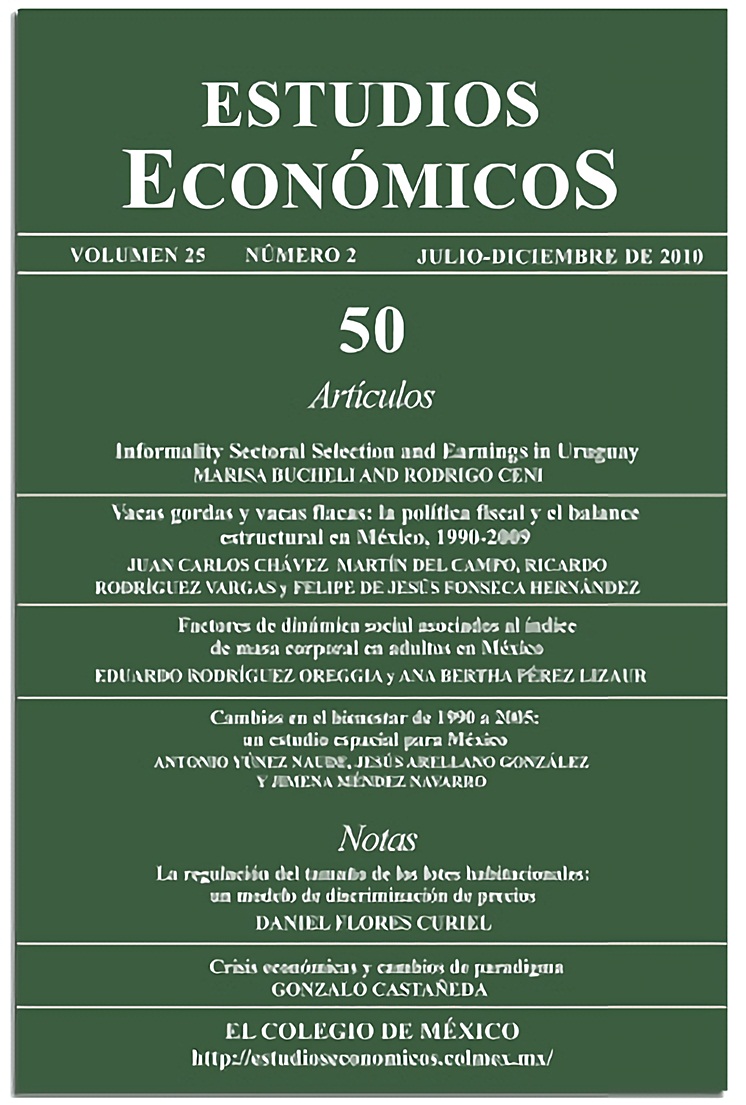Publicado 2010-07-01
Palabras clave
- paradigmas económicos,
- crisis financiera,
- teoría de complejidad social
Cómo citar
Resumen
En este ensayo se plantea que la teoría económica ortodoxa se encuentra en una encrucijada debido a su pobre desempeño para explicar la crisis financiera internacional que inició en 2008. Asimismo, se sostiene la hipótesis de que la teoría de la complejidad social es un mejor paradigma para explicar fenómenos socioeconómicos, especialmente los caracterizados por situaciones de desequilibrio y comportamientos colectivos no-lineales. En particular, se hace referencia a modelos con agentes heterogéneos sustentados en la mecánica estadística, que logran explicar el comportamiento observado en el precio de los activos mucho mejor que los modelos neoclásicos de mercados eficientes.
Descargas
Citas
- Acemoglu, D. 2009. The Crisis of 2008: Structural Lessons for and from Economics, CEPR Policy Insight, núm. 28, enero. DOI: https://doi.org/10.1080/08913810902933788
- Akerlof, G. y R. Shiller. 2009. Animal Spirits. How Human Psychology Drives the Economy, and Why it Matters for Global Capitalism, Princeton, Princeton University Press. DOI: https://doi.org/10.1515/9781400834723
- Allen, F y A. Babus. 2008. Networks in Finance, Wharton Financial Institutions Center, Working Paper núm. 08-07, ¡http://ssrn.com/abstract=1094883¿. DOI: https://doi.org/10.2139/ssrn.1094883
- Bowles, S. 2004. Microeconomics. Behavior, Institutions, and Evolution, Princeton: Princeton University Pres y Rusell Sage Foundation.
- Castañeda, G. 2009. Sociomática: el estudio de los sistemas adaptables complejos en el entorno socioeconómico, El Trimestre Económico, 76(1): 5-64. DOI: https://doi.org/10.20430/ete.v76i301.474
- Colander, D., H. Föllmer, A. Haas, M. Goldberg, K. Juselius, A. Kirman, T. Lux y B. Sloth. 2009. The Financial Crisis and the Systemic Failure of Academic Economics, Kiel Institute for the World Economy, Working Paper núm. 1489, febrero. DOI: https://doi.org/10.2139/ssrn.1355882
- Cooper, G. 2008. The Origin of Financial Crises. Central Banks, Credit Bubbles and the Efficient Market Fallacy, Nueva York: Vintage Books.
- Dell, D y I. Kristol. 1981. The Crisis in Economic Theory, Nueva York: Basic Books.
- Ehrentreich, N. 2008. Agent-Based modeling. The Santa Fe Institute Artificial Stock Market Model Revisited, Berlin: Springer-Verlag.
- Elliot, L. 2009. Financial Crisis: Economics Emerges from the Rubble in Fragile State, The Guardian, http://www.guardian.co.uk/business/2009/dec/29/future-of-economics-financial-crisis-larry-elliot, consultado 20-12-09.
- Farmer D. y J. Geanakoplos. 2009. The Virtues and Vices of Equilibrium and the Future of Financial Economics, Cowles Foundation Paper, núm. 1274.
- Fontana, M. 2008. The Complexity Approach to Economics: A Paradigm Shift, Departamento de Economía y CESMEP, Universidad de Turín, Working Paper núm. 01/2008.
- Hennings, K. y W. Samuels. 2009. Neoclassical Economic Theory, 1870 to 1930, Boston: Kluwer Academic Publishers.
- Hommes, C. y F. Wagener. 2008. Complex Evolutionary Systems in Behavioral Finance, en T. Hens y K.R. Schenk-Hoppé (comps.), Handbook of Financial Markets: Dynamics and Evolution, Academic Press. DOI: https://doi.org/10.1016/B978-012374258-2.50008-7
- Iori, G. 2002. A Micro-simulation of Traders Activity in the Stock Market: the Role of Heterogeneity, Agents’ Interactions and Trade Frictions, Journal of Economic Behavior and Organizations, 49: 269-285. DOI: https://doi.org/10.1016/S0167-2681(01)00164-0
- Kirman, A. 2009. Economic Theory and the Crisis, VOX, Research-based policy analysis and commentary from leading economists, 14 de noviembre, http://www.voxeu.org/index.php?q=node/4208, consultado 20-12-09.
- Knowledge@Wharton Staff. 2009. Why Economists Failed to Predict the Financial Crisis, 14 de mayo, http://knowledge.wharton.upenn.edu/article.cfm?articleid=2234, consultado 20-12-09.
- Kobayashi, K. 2009. Why this New Crisis Needs a New Paradigm of Economic Thought, VOX, Research-based policy analysis and commentary from leading economists, 14 de noviembre, http://www.voxeu.org/index.php?q=node/3897, consultado 20-12-09.
- Krugman, P. 2009a. How did Economists Get It so Wrong?, The New York Times, 2 de septiembre, http://www.nytimes.com/2009/09/06/magazine/06Economic-t.html, consultado 20-12-09.
- Krugman, P. 2009b. The Return of Depression Economics and the Crisis of 2008, Nueva York: W.W. Norton and Company.
- Kuhn, T. 1970. Reflections on my Critics, en I. Lakatos y A. Musgrave (comps), Criticism and the Growth of Knowledge, Londres: Cambridge University Press.
- Kuhn, T. 1962. The Structure of Scientific Revolutions, Chicago: The University of Chicago Press.
- Lux, T. y M. Marchesi. 1999. Scaling and Critically in a Stochastic Multi-agent Model of Financial Market, Nature, 397: 498-500. DOI: https://doi.org/10.1038/17290
- Mankiw, G. 2006. The Macroeconomist as Scientist and Engineer, Harvard Institute of Economic Research Working Papers, 2121. DOI: https://doi.org/10.3386/w12349
- Marchionatti, R. 2009. J. M. Keynes, Thinker of Economic Complexity, Departamento de Economía y CESMEP, Universidad de Turín, Working Paper núm. 02/2009.
- Markrose, S. 2005. Computability and Evolutionary Complexity: Markets as Complex Adaptive Systems (CAS), The Economic Journal, 115: 159-192. DOI: https://doi.org/10.1111/j.1468-0297.2005.01000.x
- Miller, J y S. Page. 2007. Complex Adaptive Systems. An Introduction to Computational Models of Social Life, Princeton: Princeton University Press.
- Shiller, R. 2008. The Subprime Solution: How Todays Global Financial Crisis Happened, and What to Do About it, Princeton: Princeton University Press.
- Spaventa, L. 2009. Economists and Economics: What does the Crisis Tell us?, CEPR Policy Insight, núm. 38.
- Tesfatsion, L. y K. Judd. 2006. Handbook of Computational Economics. Agentbased Computational Economics, vol. 2, Amsterdam: North-Holland.
- The Economist Staff. 2009. What Where Went Wrong with Economics and How the Discipline Should Change to Avoid the Mistakes of the Past, The Economist, 6 de julio, http://www.economist.com/node/14031376, consultado 20-12-09.
- Van Fraassen, B. 1980. The Scientific Image, Oxford: Claredon Press. DOI: https://doi.org/10.1093/0198244274.001.0001
- Voit J. 2005. The Statistical Mechanics of Financial Markets, Berlín: SpringerVerlag.
- Whitehouse, M. 2009. Crisis Compels Economists to Reach for New Paradigm, The Wall Street Journal, 4 de noviembre, http://cowles.econ.yale.edu/news/gean/jg091104-wsj.htm, consultado 20-12-09.
- Woodford, M. 2003. Interest and Prices: Foundations of a Theory of Monetary Policy, Princeton: Princeton University Press. DOI: https://doi.org/10.1515/9781400830169

